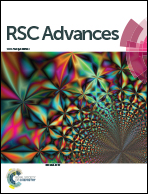Anchoring ternary CuFePd nanocatalysts on reduced graphene oxide to improve the electrocatalytic activity for the methanol oxidation reaction
Abstract
Ternary CuFePd nanocatalysts were anchored on reduced graphene oxide (rGO) by a simple one-pot chemical reduction with NaBH4 at room temperature, and used as a novel CuFePd/rGO electrocatalyst toward the methanol oxidation reaction (MOR). The CuFePd/rGO nanocatalysts were characterized by transmission electron microscopy (TEM), X-ray diffraction (XRD), X-ray photoelectron spectroscopy (XPS), energy dispersive X-ray spectroscopy (EDS), and inductively coupled plasma atomic emission spectroscopy (ICP-AES). The electrocatalytic performance for MOR was evaluated by cyclic voltammetry. The as-prepared ternary CuFePd/rGO exhibited improved activity and stability in comparison with Pd/rGO, binary CuPd/rGO, and FePd/rGO. Furthermore, the effects of the Cu to Fe composition ratio on the electrocatalytic performance are also discussed.


 Please wait while we load your content...
Please wait while we load your content...